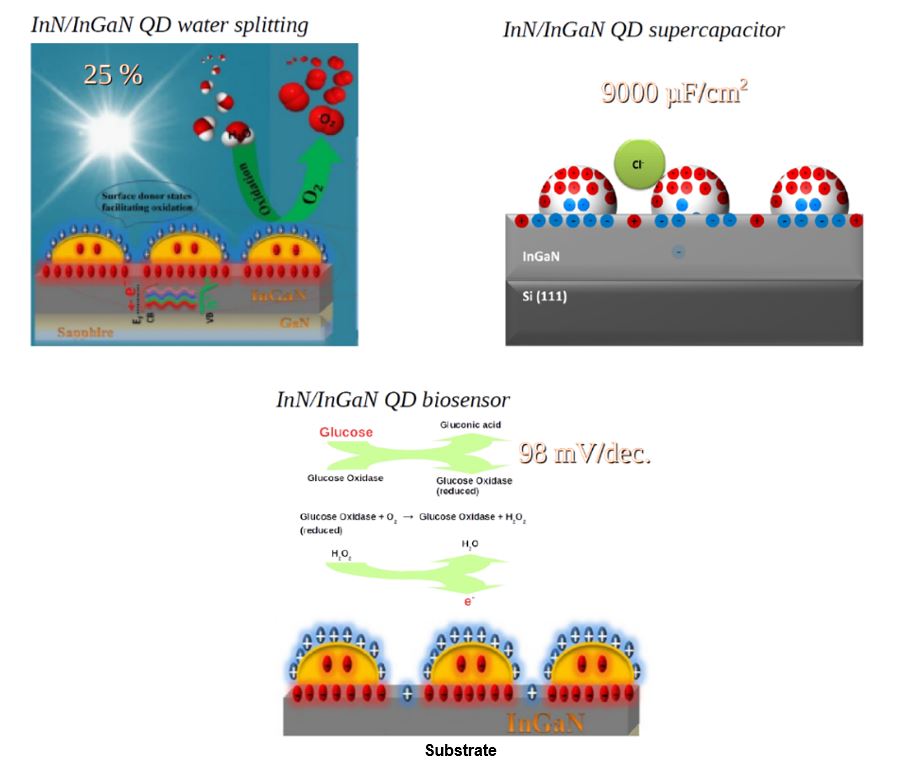Video Article Open Access
Epitaxial Quantum Dots for Optoelectronic and Electrochemical Devices
Richard Nötzel1,2
1Guangdong Provincial Key Laboratory of Optical Information Materials and Technology, South China Academy of Advanced Optoelectronics, South China Normal University, Guangzhou 510006, People’s Republic of China
2National Center for International Research on Green Optoelectronics, South China Normal University, Guangzhou 510006, People’s Republic of China
Vid. Proc. Adv. Mater., Volume 2, Article ID 2021-03159 (2021)
DOI: 10.5185/vpoam.2021.03159
Publication Date (Web): 07 May 2021
Copyright © IAAM
Graphical Abstract

Abstract
First, I will give a brief overview of my research on self-organized epitaxial quantum dots and their applications in traditional opto-electronic devices, including some basics of epitaxial growth, before coming to the current work on InN/InGaN quantum dot electrochemical devices for energy and health, opening a new research arena for III-N semiconductor nanostructures. Three key applications will be presented: (i) Photoelectrochemical solar hydrogen generation by water splitting for green solar energy harvesting and storage with record efficiencies up to 25%. (ii) Supercapacitors for the rapid storage and supply of high electrical power with areal capacitance up to 9000 µF/cm2. (iii) Biosensors for the detection of glucose and cholesterol for medical diagnostics with super-Nernstian sensitivity up to 98 mV/decade, beating the fundamental, thermodynamik kT/e limit. For all applications the superior performance based on the interplay between the unique surface properties and quantum effects of the InN/InGaN quantum dots will be highlighted, introducing a new concept, interlinking quantum nanostructure materials and physics with electrochemistry and catalysis.
Keywords
Quantum dot; InGaN; solar hydrogen; supercapacitor; biosensor.
Acknowledgement
The work is currently supported by: Program for Chang Jiang Scholars and Innovative Research Teams in Universities (No. IRT_17R40), Science and Technology Program of Guangzhou (No. 2019050001), Guangdong Provincial Key Laboratory of Optical Information Materials and Technology (Grant No. 2017B030301007), MOE International Laboratory for Optical Information Technologies and the 111 Project.
References
- R. Nötzel, J. Temmyo, T. Tamamura, Self-organized growth of strained InGaAs quantum disks, Nature, 1994, 369, 131.
- R. Nötzel, Z. C. Niu, M. Ramsteiner, H. P. Schönherr, A. Trampert, L. Däweritz, K. H. Ploog, Uniform quantum dot arrays formed by natural self-faceting on patterned substrates, Nature, 1998, 392, 56.
- R. Nötzel, InN/InGaN quantum dot electrochemical devices: New solutions for energy and health, National Science Review, 2017, 4, 184.
- R. Nötzel, On the super-Nernstian potentiometric response of InN/InGaN quantum dots, Chemical Physics Letters, 2020, 751, 137537.
Biography
Richard Nötzel received the Diploma in physics from the Technical University of Munich, Germany in 1989. From 1990 he stayed at the Max Planck Institute for Solid State Research in Stuttgart, Germany and received the doctoral degree in semiconductor physics from the University of Stuttgart in 1992. During 1993 he was with the NTT Corporation in Atsugi, Japan. In 1994 he was a Visiting Associate Professor at the Hokkaido University, Japan. From 1995 he was with the Paul Drude Institute for Solid State Electronics in Berlin, Germany. In 2000 he became Associate Professor at Eindhoven University of Technology, The Netherlands. In 2011 he joined the Technical University of Madrid, Spain as Chair of the Nanotechnology research group and from 2014 to 2016 he was Invited Professor at the University Milano Bicocca, Italy. In March 2017 he joined the South China Normal University in Guangzhou, China as full professor of the National Distinguished Expert Program of China. His work includes the direct epitaxial growth and assessment of the optical and electronic properties of nanostructured semiconductors and metals and their applications in novel functional optoelectronic and electrochemical devices. For his research he received the Otto Hahn Medal of the Max-Planck Society, the research award of the NTT Opto-electronics Laboratories, and the Academy Award of the Berlin-Brandenburg Academy of Science. The research resulted in more than 500 scientific publications and patents.
Video Proceedings of Advanced Materials

Upcoming Congress



